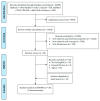Evaluating Self-Concept Measurements in Adolescents: A Systematic Review
- PMID: 36832528
- PMCID: PMC9954829
- DOI: 10.3390/children10020399
Evaluating Self-Concept Measurements in Adolescents: A Systematic Review
Abstract
(1) Background: To evaluate the self-concept of adolescents, a proper evaluation of several existing self-concept measurements is needed. The objectives of this study are to conduct a systematic review of the available measures used to assess self-concept in adolescents, to evaluate the psychometric properties of each measurement, and to assess the attributes of patient-reported outcome measurements (PROMs) of self-concept in adolescents. (2) Methods: The systematic review was conducted on six databases: EMBASE, MEDLINE, Cochrane, PubMed, CINAHL, and Web of Science, from inception to 2021. A standardized evaluation of psychometric properties was carried out using the Evaluating the Measurement of Patient-Reported Outcomes (EMPRO). The review was conducted independently by two reviewers. Each attribute in EMPRO was assessed and analyzed to obtain an overall score. Only scores that exceeded 50 were considered acceptable. (3) Results: From 22,388 articles, we reviewed 35 articles with five self-concept measurements. Four measurements were obtained that had values above the threshold (SPPC, SPPA, SDQ-II, and SDQII-S). However, there is not enough evidence to support the interpretability attribute in self-concept measurement. (4) Conclusions: There are various measurements of self-concept in adolescents accompanied by their psychometric properties. Each measurement of adolescent self-concept has a characteristic of psychometric properties and measurement attributes.
Keywords: adolescent; psychometric properties; self-concept.
Conflict of interest statement
The authors declare no conflict of interest.
References
-
- Marsh H.W., Shavelson R. Self-concept: Its multifaceted, hierarchical structure. Educ. Psychol. 1985;20:107–123. doi: 10.1207/s15326985ep2003_1. - DOI
-
- Oyserman D. Blackwell Handbook of Social Psychology: Intraindividual Processes. Blackwell Publishing; Malden, MA, USA: 2001. Self-Concept and Identity; pp. 499–517.
-
- Harter S. Handbook of Child Psychology, Social, Emotional, and Personality Development. John Wiley & Sons Inc; Hoboken, NJ, USA: 2006. The self; pp. 505–570.
-
- Kozina A. The Development of Multiple Domains of Self-Concept in Late Childhood and in Early Adolescence. Curr. Psychol. 2019;38:1435–1442. doi: 10.1007/s12144-017-9690-9. - DOI
Publication types
LinkOut - more resources
Full Text Sources


